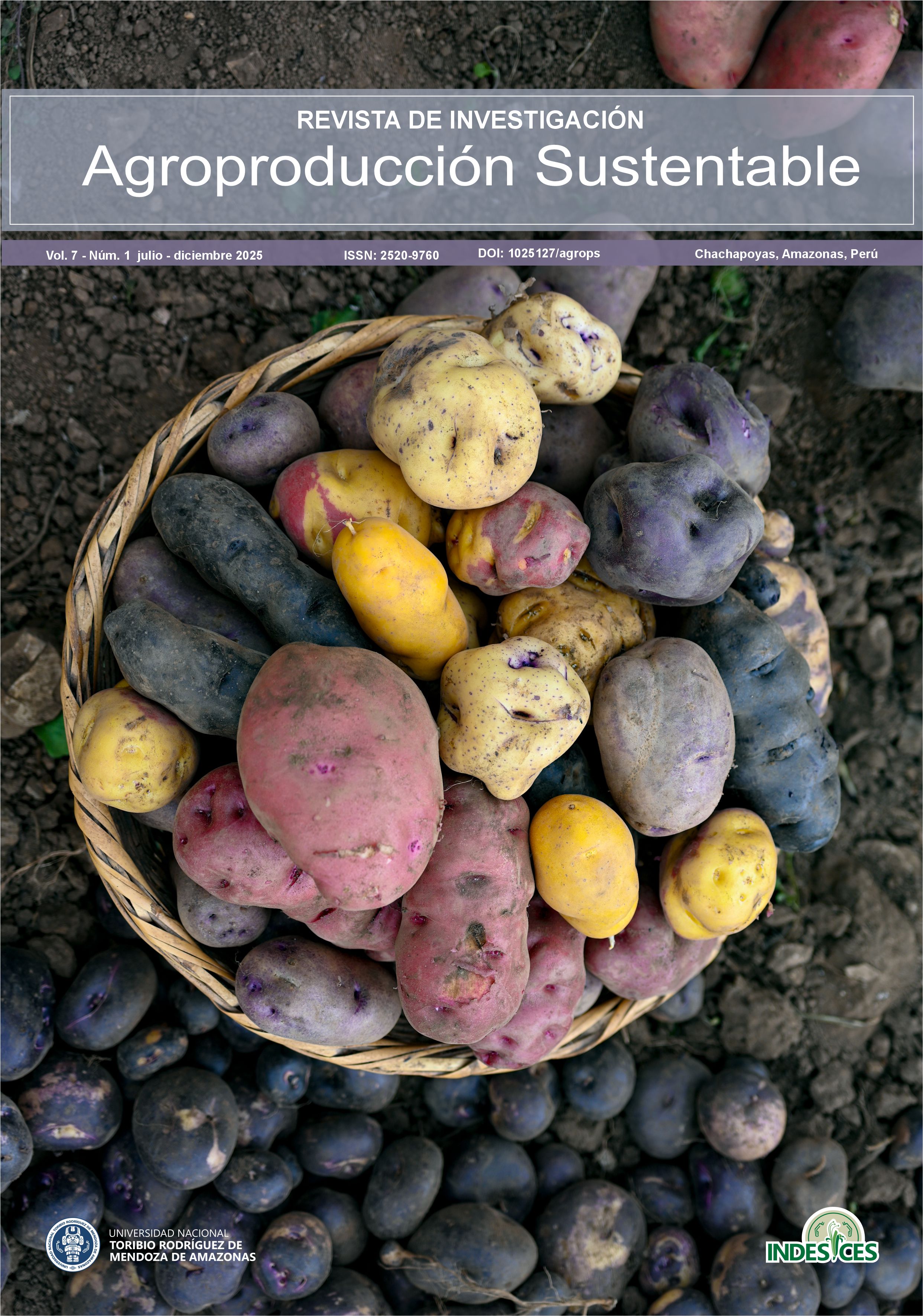Application of microbial consortia for the sustainable production of potato seeds var. Unique in the Southern Highlands of Peru
DOI:
https://doi.org/10.25127/agrops.20251.1121Keywords:
bioinoculación, calidad de semilla, consorcios microbianos, Solanum tuberosum, TrichodermaAbstract
Soil microorganisms hold considerable promise for the development of integrated, sustainable agricultural systems. In particular, synergistic interactions between fungi and nitrifying bacteria enhance crop growth and productivity. This study evaluated microbial consortia designed to increase vegetative growth, seed-tuber production, and crop yield of Solanum tuberosum L. cv. Única under high-Andean conditions in Arequipa, Peru. A randomized complete-block design with three replicates was employed. Plant height, stem number, yield components disaggregated by tuber grade (RS1–RS3 and marketable tubers > 120 g), seed-tuber number per plant, and dry-matter content were recorded and compared using Tukey’s test (p < 0.05). The combination Trichoderma harzianum/viride + effective microorganisms (T2) increased plant height by 40 % over the uninoculated control and achieved the highest total yield (31.8 t ha⁻¹). The treatment T. harzianum/viride + Azotobacter salinestris (T1) tripled marketable-tuber yield (20.9 t ha⁻¹), whereas MOBs-INIA + T. harzianum/viride (T3) produced 9.39 t ha⁻¹ of first-grade seed tubers and 0.43 t ha⁻¹ of third-grade seed tubers, more than doubling total seed-tuber yield relative to the control (T5). Microbial consortia formed superior statistical groups for seed-tuber number and grades RS1–RS3. Dry-matter content and branching did not differ significantly, although slight improvements were observed in T1 and T2. Collectively, the results support coinoculation with fungal–bacterial consortia as a sustainable strategy to enhance yield and seed availability while reducing chemical fertiliser inputs in the Arequipa region.
Downloads
Published
Issue
Section
License
Copyright (c) 2025 María Elena Torres-Limascca, Isabel Cordova-Tarifa, Kevin García-Lopez, Grecia Coaquira-Rios, Daniel Matsusaka-Quiliano

This work is licensed under a Creative Commons Attribution-NonCommercial-ShareAlike 4.0 International License.
Aquellos autores/as que tengan publicaciones con esta revista, aceptan los términos siguientes:
- Los autores/as conservarán sus derechos de autor y garantizarán a la revista el derecho de primera publicación de su obra, el cuál estará simultáneamente sujeto a la Licencia de reconocimiento de Creative Commons. Por tanto:
Usted es libre de:
- Compartir — copiar y redistribuir el material en cualquier medio o formato
- Adaptar — remezclar, transformar y construir a partir del material
- La licenciante no puede revocar estas libertades en tanto usted siga los términos de la licencia
Bajo los siguientes términos:
Atribución — Usted debe dar crédito de manera adecuada, brindar un enlace a la licencia, e indicar si se han realizado cambios. Puede hacerlo en cualquier forma razonable, pero no de forma tal que sugiera que usted o su uso tienen el apoyo de la licenciante.
NoComercial — Usted no puede hacer uso del material con propósitos comerciales.
CompartirIgual — Si remezcla, transforma o crea a partir del material, debe distribuir su contribución bajo la lamisma licencia del original.
- No hay restricciones adicionales — No puede aplicar términos legales ni medidas tecnológicas que restrinjan legalmente a otras a hacer cualquier uso permitido por la licencia.
- Los autores/as podrán adoptar otros acuerdos de licencia no exclusiva de distribución de la versión de la obra publicada (p. ej.: depositarla en un archivo telemático institucional o publicarla en un volumen monográfico) siempre que se indique la publicación inicial en esta revista.
- Se permite y recomienda a los autores/as difundir su obra a través de Internet (p. ej.: en archivos telemáticos institucionales o en su página web) antes y durante el proceso de envío, lo cual puede producir intercambios interesantes y aumentar las citas de la obra publicada. (Véase El efecto del acceso abierto).

Esta obra está bajo una Licencia Creative Commons Atribución-NoComercial-CompartirIgual 4.0 Internacional


